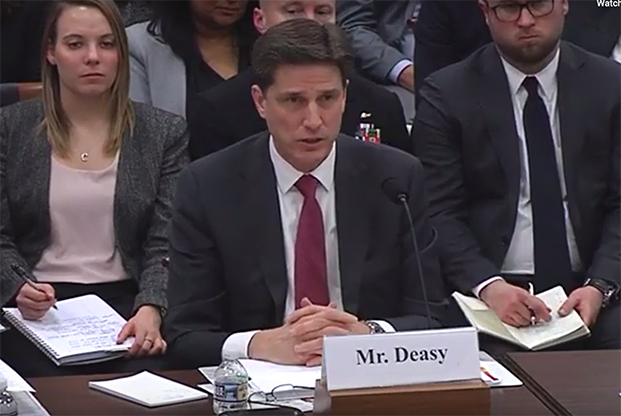
Pentagon CIO Dana Deasy testifies before the House Armed Services Committee on Feb. 27, 2019. HASC screenshot.
The Defense Department’s push to embrace cloud computing and artificial intelligence through high-profile, top-level initiatives needs some time to mature before they can work with similar projects managed by the services, said Dana Deasy, the Pentagon’s chief information officer.
A $10 billion commercial cloud initiative known as the Joint Enterprise Defense Infrastructure program aims to be the DOD’s central data and software repository, a new home for decades’ worth of stovepiped system information.
Many of the Defense Department’s more than 500 cloud initiatives would fare best on a general-purpose cloud like JEDI, Deasy said. But DOD won’t try to merge those programs early on in development, and instead will keep funding and staffing the lesser projects until the overarching cloud is nearly ready.
“I am a strong believer that the vast majority, probably 85 percent, 90 percent, of all things in the future that we were to build, could go onto either a fit-for-purpose or a general-purpose cloud,” Deasy said at a House Armed Services intelligence, emerging threats, and capabilities subcommittee hearing Tuesday. “The sheer cost and the magnitude of lifting them and ‘re-porting’ them onto the cloud would be cost-prohibitive, would be time-prohibitive, and would probably not serve the department well.”
About 60 days before JEDI goes live, Deasy said employees could “go back to some of the early portions of those cloud initiatives where they’re still in the early days and redirect them” to work within the new infrastructure.
“The fine line we’re walking right now is not to impede the need for mission success, where people are standing up on the cloud,” he said. Lesser cloud projects will transfer to JEDI “as soon as we can provide clarity to the DOD on when the enterprise cloud will be available.”
Amazon Web Services, IBM, Oracle, and Microsoft are competing to provide the cloud hardware and software that promises to reshape how defense information is stored and shared.
The contentious procurement was interrupted by an Oracle lawsuit alleging the Defense Department unfairly favors Amazon, and recent reports show the program is likely to be delayed by at least three months while the Pentagon investigates conflict-of-interest claims.
Deasy raised concerns that slowing the program’s progress will push the services farther down their own paths instead of bringing them together.
“Our enterprise cloud for the first time allows us to establish a common platform where we can bring data together in a common way,” he told Rep. Michael Waltz (R-Fla.). “The longer we delay standing up a JEDI capability … the military services are going to need to go solve for mission sets, and they’re going to continue to stand up in their own individual environments. And I don’t see that as being beneficial over the long term to the department.”
Similarly, the Pentagon wants to find its footing at the new Joint Artificial Intelligence Center before the organization starts to integrate other AI initiatives underway across the military. After receiving its first funding at the end of 2018, Deasy said, JAIC is bringing in its first uniformed and civilian employees and is getting started on two initiatives: using AI to improve predictive maintenance and natural-disaster response.
“The value of JAIC is to take those algorithms that are developed for purpose A and be able to reapply them elsewhere inside the Department of Defense,” he continued. “We are learning how to quickly get a flywheel going of how to bring in and integrate these initiatives. … Our flywheel is about 60-some-days old now, and we’re integrating at a rapid rate.”
Once JAIC accomplishes more on its own, officials will determine whether other AI programs around the department show enough promise to become an overarching “national mission initiative,” or if they would work better as a component of a larger project. JAIC can take up those components if they hit a certain dollar value and need an extra level of guidance, Deasy said.
He responded to concerns from subcommittee ranking member Rep. Elise Stefanik (R-N.Y.), who questioned whether the Pentagon is truly taking a “whole-of-department approach.”
“We need to continue pushing the department when it comes to how we are addressing AI, because I’m fearful we’re falling behind our adversaries in terms of how they are addressing this,” she said.
In addition to bridging gaps between top-level and service-level AI research, the JAIC is also expected to forge new relationships with the private sector and academia.
“We’re going to need a number of national mission initiatives in different areas,” Deasy said. “China may be at a level of investment … [that] is quite significantly higher, but if you look at the vast talent, the U.S. still holds the majority of the talent when it comes to AI. And what we have to do is we have to learn how to quickly leverage and bring that talent in.”